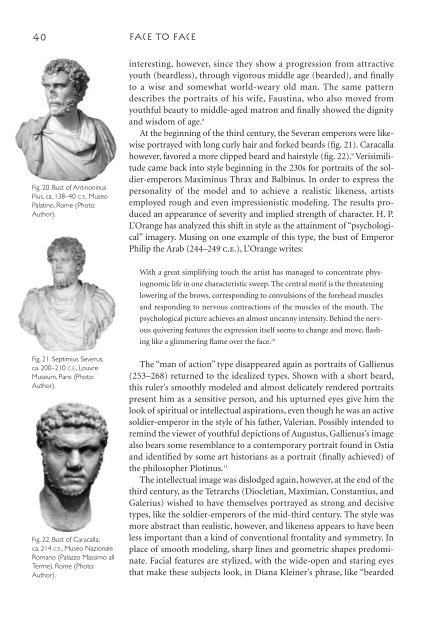Create successful ePaper yourself
Turn your PDF publications into a flip-book with our unique Google optimized e-Paper software.
40<br />
Fig. 20. Bust of Antinoninus<br />
Pius, ca. 138–40 C.E., Museo<br />
Palatino, Rome (Pho<strong>to</strong>:<br />
Author).<br />
Fig. 21. Septimius Severus,<br />
ca. 200–210 C.E., Louvre<br />
Museum, Paris (Pho<strong>to</strong>:<br />
Author).<br />
Fig. 22. Bust of Caracalla,<br />
ca. 214 C.E., Museo Nazionale<br />
Romano (Palazzo Massimo all<br />
Terme), Rome (Pho<strong>to</strong>:<br />
Author).<br />
Face <strong>to</strong> face<br />
interesting, however, since they show a progression from attractive<br />
youth (beardless), through vigorous middle age (bearded), and finally<br />
<strong>to</strong> a wise and somewhat world-weary old man. The same pattern<br />
describes the portraits of his wife, Faustina, who also moved from<br />
youthful beauty <strong>to</strong> middle-aged matron and finally showed the dignity<br />
and wisdom of age. 8<br />
At the beginning of the third century, the Severan emperors were likewise<br />
portrayed with long curly hair and forked beards (fig. 21). Caracalla<br />
however, favored a more clipped beard and hairstyle (fig. 22). 9 Verisimilitude<br />
came back in<strong>to</strong> style beginning in the 230s for portraits of the soldier-emperors<br />
Maximinus Thrax and Balbinus. In order <strong>to</strong> express the<br />
personality of the model and <strong>to</strong> achieve a realistic likeness, artists<br />
employed rough and even impressionistic modeling. The results produced<br />
an appearance of severity and implied strength of character. H. P.<br />
L’Orange has analyzed this shift in style as the attainment of “psychological”<br />
imagery. Musing on one example of this type, the bust of Emperor<br />
Philip the Arab (244–249 c.e.), L’Orange writes:<br />
With a great simplifying <strong>to</strong>uch the artist has managed <strong>to</strong> concentrate physiognomic<br />
life in one characteristic sweep. The central motif is the threatening<br />
lowering of the brows, corresponding <strong>to</strong> convulsions of the forehead muscles<br />
and responding <strong>to</strong> nervous contractions of the muscles of the mouth. The<br />
psychological picture achieves an almost uncanny intensity. Behind the nervous<br />
quivering features the expression itself seems <strong>to</strong> change and move, flashing<br />
like a glimmering flame over the face. 10<br />
The “man of action” type disappeared again as portraits of Gallienus<br />
(253–268) returned <strong>to</strong> the idealized types. Shown with a short beard,<br />
this ruler’s smoothly modeled and almost delicately rendered portraits<br />
present him as a sensitive person, and his upturned eyes give him the<br />
look of spiritual or intellectual aspirations, even though he was an active<br />
soldier-emperor in the style of his father, Valerian. Possibly intended <strong>to</strong><br />
remind the viewer of youthful depictions of Augustus, Gallienus’s image<br />
also bears some resemblance <strong>to</strong> a contemporary portrait found in Ostia<br />
and identified by some art his<strong>to</strong>rians as a portrait (finally achieved) of<br />
the philosopher Plotinus. 11<br />
The intellectual image was dislodged again, however, at the end of the<br />
third century, as the Tetrarchs (Diocletian, Maximian, Constantius, and<br />
Galerius) wished <strong>to</strong> have themselves portrayed as strong and decisive<br />
types, like the soldier-emperors of the mid-third century. The style was<br />
more abstract than realistic, however, and likeness appears <strong>to</strong> have been<br />
less important than a kind of conventional frontality and symmetry. In<br />
place of smooth modeling, sharp lines and geometric shapes predominate.<br />
Facial features are stylized, with the wide-open and staring eyes<br />
that make these subjects look, in Diana Kleiner’s phrase, like “bearded


